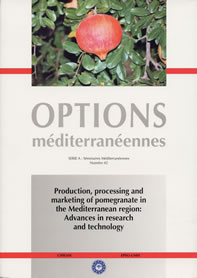| Article précédent | p. 129-135 | Article suivant |
Characterization of the fruit of five pomegranate (Punica granatum L.) clones cultivated in homogeneous soils
We have made a morphological study of the fruit and seeds of five pomegranate clones, PTO9, ADO4, ME15, MO2 and BA1, and analysed the chemical characteristics of the juice. Mean fruit weight was greatest in ADO4, followed by MO2 and PTO9, while the fruits of ME15 were the smallest. There was a clear correlation between the overall production of these trees and mean fruit size and weight, with ME15 being the most productive (46.7 kg per tree) and ADO4 the least (12 kg per tree). The greatest seed production (70.69 per cent) was obtained with ADO4, followed by the 65.1 per cent of ME15. The lowest values were those of BA1 (48.52 per cent). The largest seeds were those of ADO4 (0.53 g) and the smallest those of ME15 (0.31 g). Maximum values for juice were obtained with BA1 and PTO9 (50 and 55 ml per 100 g of seeds). Clones ME15 and ADO4 showed intermediate values (44 and 47 ml per 100 g of seeds respectively), while MO2 only produced 35 ml of juice per 100 g of seeds.
- [ Afficher ]
- [ Télécharger ]
- [ Exporter la citation ]
Vous pouvez télécharger la citation au format :
- [ Imprimer ]
-
Mots-clés
ANATOMIE VEGETALE, FRUIT, GRAINE, PUNICA GRANATUMCiter cet article
Amorós A., Melgarejo P., Martínez J.J., Hernández F., Martínez J. Characterization of the fruit of five pomegranate (Punica granatum L.) clones cultivated in homogeneous soils. In : Melgarejo P. (ed.), Martínez-Nicolás J.J. (ed.), Martínez-Tomé J. (ed.). Production, processing and marketing of pomegranate in the Mediterranean region: Advances in research and technology. Zaragoza : CIHEAM, 2000. p. 129-135. (Options Méditerranéennes : Série A. Séminaires Méditerranéens; n. 42). Symposium on 'Production, processing and marketing of pomegranate in the Mediterranean region: Advances in research and technology', 1998/10/15-17, Orihuela (Spain). http://om.ciheam.org/om/pdf/a42/00600262.pdf



